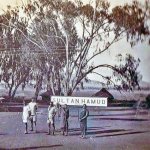
What is in a name?
The Duruma Chief Mazera, gave his name to "the place of Mazera" or Mazeras where he once lived. In the earlier caravan days Mazeras was known as "Ganjoni" or "the place of ruins" owing to its being frequently attacked by the Masai.
Mariakani is also of Duruma origin. The word, which means the "place of quivers", is derived from the native tradition that the Duruma and the Wakamba warriors met at this place in embattled array. The Wakamba were defeated and, as they fled, they discarded their arrows covering the battle field with them.
"Maji-ya-Chumvi" was originally known as "Gulugulu" which among the Mijikenda was the name of a local stream. The name was later changed during the Swahili slave caravan era to its present version which means "salt water".
"Samburu", between Mombasa and Voi was called "Kirauho" by the Mijikenda and the name "Samburu" was coined by slave caravans to denote
the last waterhole (except a small one which existed at Maungu) before Voi.
A story is told that the Swahili caravans were urged on to the Maungu and Voi waterholes by the Duruma herds shouting "Sambiburi", which may be taken to mean "Buzz along! buzz along!"
Mackinnon Road is, of course, named after Sir William Mackinnon, who played a leading role in the early development of the country.
"Maungu" means "a back" in Swahili. It is, however, thought possible that this word is a corruption of "Mayungi" which means water lilies found in the waterhole on a nearby hill. The proper name for the station according to some historians should be "Marungu", the Taita name for the hill.
According to many Wataita Voi should be called "Ore" . The name Voi is a Ki-gunya/Bajuni word for gruel; the story being that the stream at Voi often dwindled to a mere trickle and, on this account, only a small amount of gruel could be cooked by the Wa-Gunya/Bajuni slave raiders who normally hurried to Mbululu, the camp after Voi.
"N'di" is a Kikamba word for a "mortar" derived from the resemblance to a mortar of a rock close to the station.
"Tsavo" is a Kikamba word for "slaughter",. However, the word has no connection with the slaughter of numbers of Indian coolies in the days of construction of Uganda Railway. In fact, it relates to the erstwhile devastations of the Masai.
"Mtito-Andei" is, of course, "Mtito-wa-Ndei" or "The Forest of Kites". The Masai are said to have constantly laid in-waiting in a nearby forest with intent to attack the Wakamba, following which many were killed. The kites remained in the surrounding forests and fed on the corpses. After wards, the local river and station were both known as "Mtito Andei".
"Masongaleni" or more correctly "Mithongoleni" means the place of poisoned sticks. The word is derived from the poisoned sticks stuck by the Wakamba round their shambas to prevent bush buck from eating their produce.
To the Wakamba "Kibwezi" was always known as "Kivwetse" which is said to have been derived from a former Scottish Mission in the vicinity. In the Mission garden was a volcanic rock which, after a series of seismic movements, split and caused an underground stream to flow above ground near Kibwezi. Το the faithful ones, science is often cold and ungodly; but there can be little doubt that the godly believed that the Mission padre struck the rock with his rod, in much the same way as did Moses of old thereby causing water to flow.
"Makindu", which is taken from the name of a nearby river was formerly known as "Kiumbi" (Kikamba for "the one by himself"). In Swahili, however, Makindu means "palm trees". Therefore, according to some historians the place should more correctly be known as "Makinduni"- the place of palms.
Formerly, it is said, this stream was a dry river bed with a series of disconnected pools of water. thus resembling a man who is alone and silent "Kiumbi!" Seismic disturbances similar to those that caused Kibwezi to flow overground started a permanent stream which caused the palms to grow.
"Sultan Hamud" is named after a Sultan of Zanzibar. Hamud bin Muhammad, to mark his visit to rail head at this point (Mile 248) in 1898. In the company of the Sultan was the notorious historical figure and slave raider, Tippu Tib, whose name was derived from the sound made by his guns.
The full name for "Kiu" is "Kilima Kiu" which is Kikamba for "the black mountain". The old caravan road wound around the Kiu hills which were dark, sombre and forbidding, providing no light patches.
"Konza's" original name was Machakos Road. From here a road went to the place of Masaku an early Wakamba Chief. The place of Masaku (Machakos)
"Em-Bagasi" or "Mbagathi" is the Masai name of the stream that crosses on the Nairobi-Ngong road and which flows through the Nairobi National Park to the east. It is interesting to note that the Ngong Road was originally built out of the pro ceeds of a 15,000-rupee fine inflicted by the Masai paramount Chief Lenana on certain turbulent young warriors of his tribe the "elmoran".
